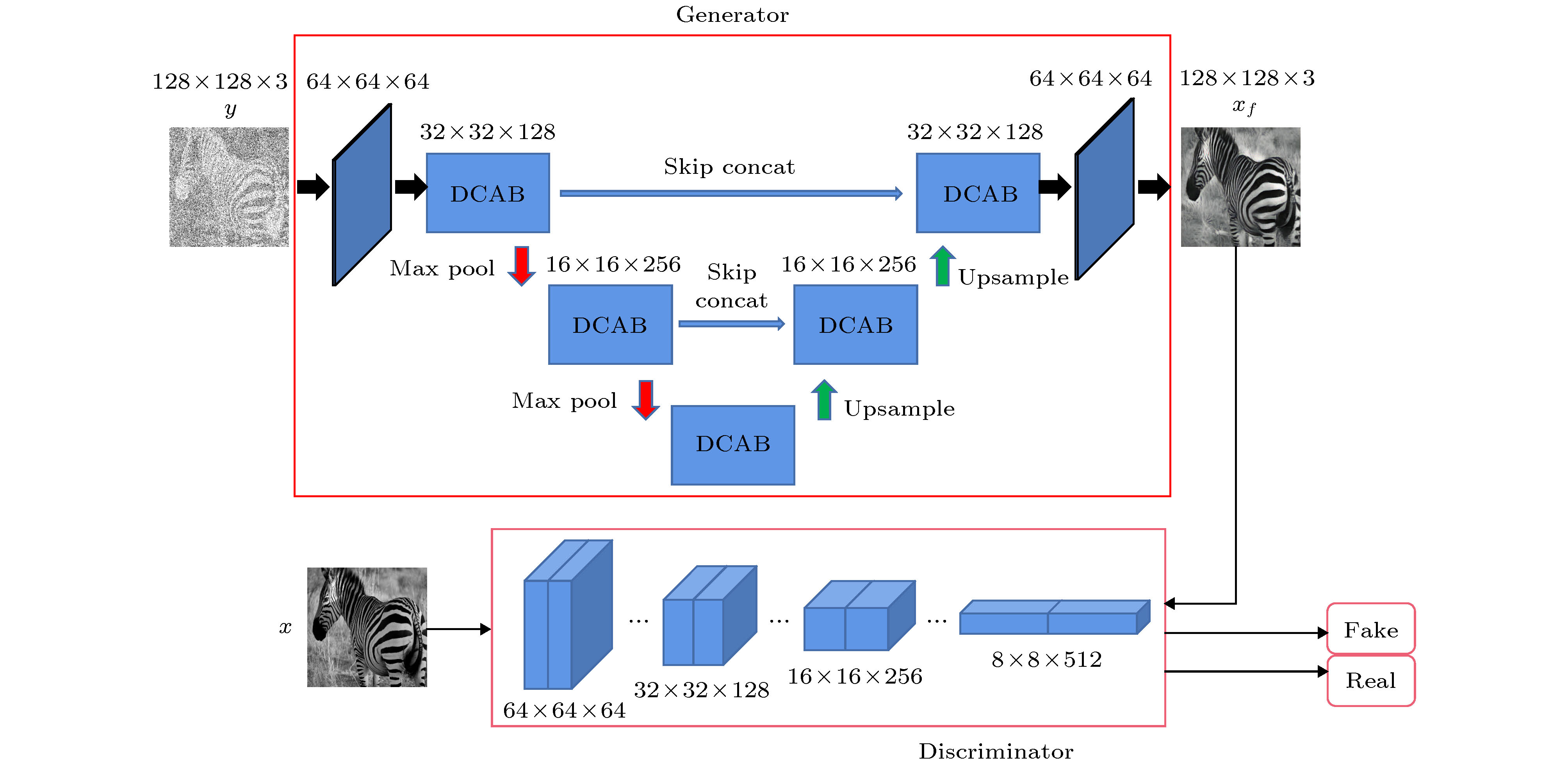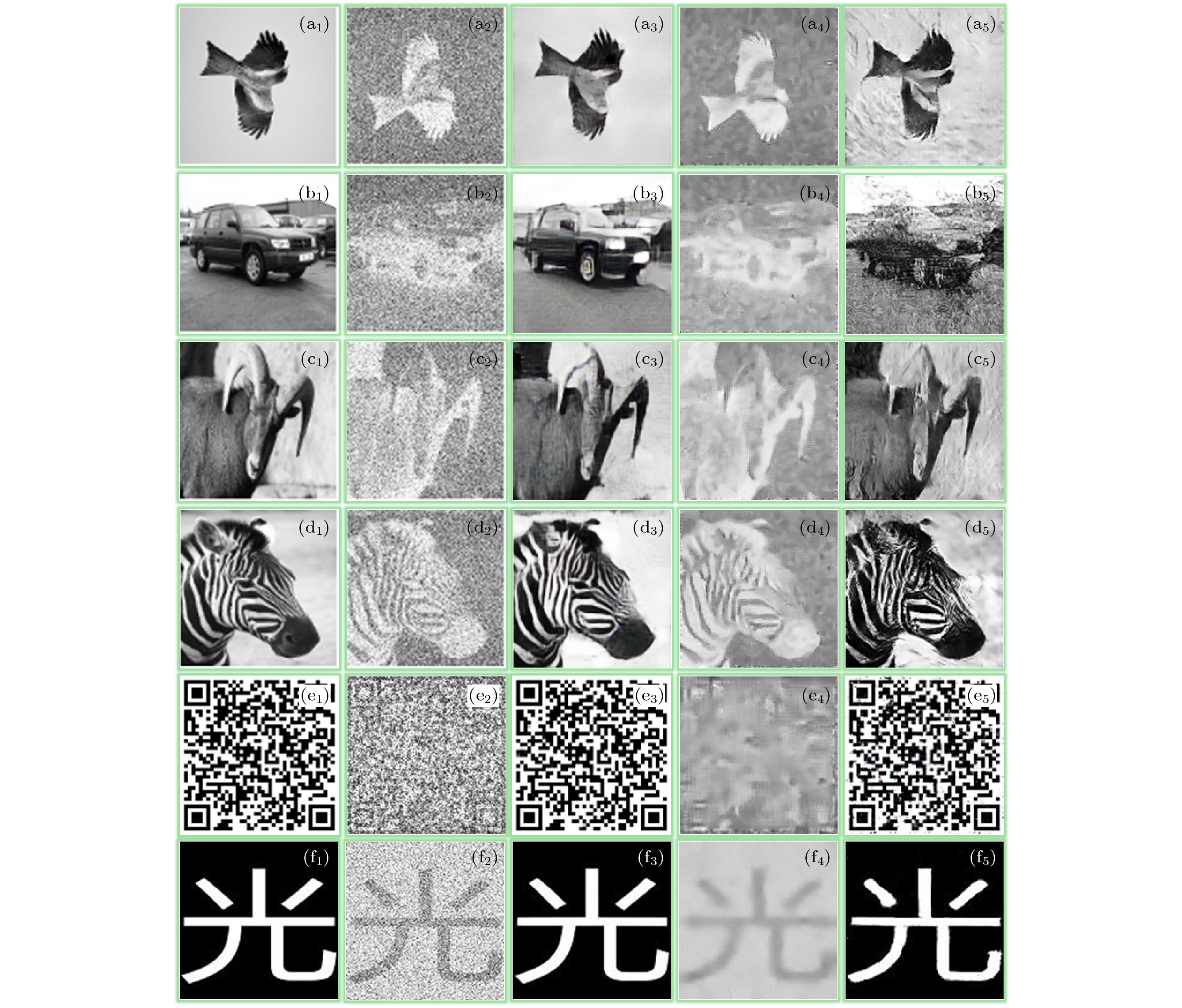-
There is serious noise interference in the decryption process of the joint transform correlator (JTC) optical encryption system, so the quality of the decrypted image cannot meet the accuracy requirements in most cases. The quality of decrypted image can be improved to a certain extent when the phase key is designed by the Gerchberg-Saxton algorithm and the iterative algorithm fuzzy control algorithm, but the complexity of the design process is inevitable and the quality of the decrypted image still needs improving. Recently, the in depth learning technology has attracted the attention of scholars in the fields of computer vision, natural language processing and optical information processing. In order to deal with the noise interference in the JTC optical encryption system, combining the current deep learning method, in this paper we propose a new denoising method for JTC optical image encryption system based on in depth learning, the dense modules are added into the generated network to enhance the reuse of feature information and improve the performance of the network. The latest self-attention mechanism area is added into the network to distinguish the weights of different channels and learn the relationship between channel and channel, so that the network can selectively strengthen the useful feature information but suppress useless feature information. The density module and the channel attention module are integrated into a DCAB synthesis module, which can effectively extract the image feature information and improve the performance of the network. The receptive field of the convolution kernel is enlarged by two down-sampling and the feature map is restored to its original size by two up-sampling. The VGG-19 is used to extract high-frequency details and texture features of images, meanwhile, the non-adversarial loss and mean-square error (MSE) loss are added into the loss function to reduce the difference among the image samples. The quality of noise-reduced images in this method are obviously better than that of the existing denoising algorithms by evaluating intuitive visual observation or SSIM (structural similarity), PSNR (peak signal to noise ratio) and MSE. The results of numerical calculation and simulation experiments show that this method can greatly eliminate the influence of noise on the JTC optical image encryption system, and effectively improve the effectiveness and feasibility of JTC optical image encryption system for high-quality image encryption.
-
Keywords:
- optical image encryption /
- deep learning /
- information security /
- neural networks /
- joint transform correlator
[1] Refregier P, Javidi B 1995 Opt. Lett. 20 767
 Google Scholar
Google Scholar
[2] Javidi B, Carnicer A, Yamaguchi M, Nomura T, Pérez-Cabré E, Millán M S, Nishchal N K, Torroba R, Barrera J F, He W, Peng X, Stern A, Rivenson Y, Alfalou A, Brosseau C, Guo C, Sheridan J T, Situ G, Naruse M, Matsumoto T, Juvells L, Tajahuerce E, Lancis J, Chen W, Chen X, Pinkse P W, Mosk A P, Markman A 2016 J. Opt. 18 083001
 Google Scholar
Google Scholar
[3] 潘武, 田贻丽 2005 光学精密工程 13 15
 Google Scholar
Google Scholar
Pan W, Tian Y L 2005 Opt. Precision Eng. 13 15
 Google Scholar
Google Scholar
[4] Javidi B, Nomura T 2000 Opt. Lett. 25 28
 Google Scholar
Google Scholar
[5] Rueda E, Barrera J F, Henao R 2009 Opt. Commun. 282 3243
 Google Scholar
Google Scholar
[6] Rajput S K, Nishchal N K 2012 Opt. Lasers Eng. 50 1474
 Google Scholar
Google Scholar
[7] Mehra I, Rajput S K, Nishchal N K 2014 Opt. Lasers Eng. 52 167
 Google Scholar
Google Scholar
[8] Cheng C J, Lin L C, Wang C M 2005 Opt. Rev. 12 367
 Google Scholar
Google Scholar
[9] Lin L C, Cheng C J 2006 Opt. Commun. 258 144
 Google Scholar
Google Scholar
[10] Rao J M, Qiao Y J, Ren F, Wang J X, Du Q Y 2017 Sensors 17 1951
 Google Scholar
Google Scholar
[11] Chen L C, Papandreou G, Kokkinos I 2018 IEEE T. Pattern Anal. 40 834
 Google Scholar
Google Scholar
[12] Johnson J, Karpathy A, Li F F, Las Vegas N V 2016 Proceeding of IEEE Conference on Computer Vision and Pattern Recognition Las Vegas, NV, USA, Dec 12, 2016 p494
[13] Lateef F, Ruichek Y 2019 Neurocomputing 338 321
 Google Scholar
Google Scholar
[14] Phiillp I, Zhu J Y, Zhou T H, Alexei A E 2017 Proc of IEEE Conf. on Computer Vision and Pattern Recognition Honolulu, HI, United States, Nov 11, 2017 p632
[15] Ronneberger O, Fischer P, Brox T 2015 Internation Conference on Medical Image Computing and Computer Assisted Interventions Munich, Germany, Nov 18, 2015 p234
[16] He K, Zhang X, Ren S, Sun J 2016 Proceeding of IEEE Conference on Computer Vision and Pattern Recognition Las Vegas N V, United States, June 26–July 1, 2016 p770
[17] Li K, Wu Z, Peng K C, Ernst J, Fu Y 2018 Proceeding of IEEE Conference on Computer Vision and Pattern Recognition Salt Lake City UT, United States, Dec 17, 2018 p9215
[18] Huang G, Liu Z, Weinberger K Q, Der M 2017 Proceeding of IEEE Conference on Computer Vision and Pattern Recognition Honolulu, HI, United States, July 21–26, 2017 p2261
[19] Ioffe S, Szegedy C 2015 Proceedings of The 32nd International Conference on Machine Learning (ICML) Lille France, July 6–11, 2015 p448
[20] 吴克难, 胡家升, 林勇 2007 光学精密工程 4 577
 Google Scholar
Google Scholar
Wu K N, Hu J S, Lin Y 2007 Opt. Precision Eng. 4 577
 Google Scholar
Google Scholar
-
图 4 通道注意力模块, 其中x表示特征图, c表示特征图(通道)数量,
${w_{\rm{1}}}$ 和${w_{\rm{2}}}$ 分别表示降维前后的权重,$\sigma $ 是sigmod激活函数,$p({x_c})$ 表示全局池化功能Figure 4. Channel attention (CA), Where x is the feature map, c is the channel,
${w_1}$ and${w_2}$ are the weight set of low-dimension,$\sigma $ is the sigmod activation function and$p({x_c})$ is global pooling function.表 1 5种去噪方法结果对比
Table 1. Comparison of experimental data results.
指标 PSNR MSE SSIM BM3D 11.4615 4708.7266 0.0556 pix2pix 17.4363 1334.5201 0.4285 G-S 12.4521 3834.3358 0.1598 IAFC 19.0561 731.2579 0.5784 本文方法 22.4049 421.0133 0.7398 -
[1] Refregier P, Javidi B 1995 Opt. Lett. 20 767
 Google Scholar
Google Scholar
[2] Javidi B, Carnicer A, Yamaguchi M, Nomura T, Pérez-Cabré E, Millán M S, Nishchal N K, Torroba R, Barrera J F, He W, Peng X, Stern A, Rivenson Y, Alfalou A, Brosseau C, Guo C, Sheridan J T, Situ G, Naruse M, Matsumoto T, Juvells L, Tajahuerce E, Lancis J, Chen W, Chen X, Pinkse P W, Mosk A P, Markman A 2016 J. Opt. 18 083001
 Google Scholar
Google Scholar
[3] 潘武, 田贻丽 2005 光学精密工程 13 15
 Google Scholar
Google Scholar
Pan W, Tian Y L 2005 Opt. Precision Eng. 13 15
 Google Scholar
Google Scholar
[4] Javidi B, Nomura T 2000 Opt. Lett. 25 28
 Google Scholar
Google Scholar
[5] Rueda E, Barrera J F, Henao R 2009 Opt. Commun. 282 3243
 Google Scholar
Google Scholar
[6] Rajput S K, Nishchal N K 2012 Opt. Lasers Eng. 50 1474
 Google Scholar
Google Scholar
[7] Mehra I, Rajput S K, Nishchal N K 2014 Opt. Lasers Eng. 52 167
 Google Scholar
Google Scholar
[8] Cheng C J, Lin L C, Wang C M 2005 Opt. Rev. 12 367
 Google Scholar
Google Scholar
[9] Lin L C, Cheng C J 2006 Opt. Commun. 258 144
 Google Scholar
Google Scholar
[10] Rao J M, Qiao Y J, Ren F, Wang J X, Du Q Y 2017 Sensors 17 1951
 Google Scholar
Google Scholar
[11] Chen L C, Papandreou G, Kokkinos I 2018 IEEE T. Pattern Anal. 40 834
 Google Scholar
Google Scholar
[12] Johnson J, Karpathy A, Li F F, Las Vegas N V 2016 Proceeding of IEEE Conference on Computer Vision and Pattern Recognition Las Vegas, NV, USA, Dec 12, 2016 p494
[13] Lateef F, Ruichek Y 2019 Neurocomputing 338 321
 Google Scholar
Google Scholar
[14] Phiillp I, Zhu J Y, Zhou T H, Alexei A E 2017 Proc of IEEE Conf. on Computer Vision and Pattern Recognition Honolulu, HI, United States, Nov 11, 2017 p632
[15] Ronneberger O, Fischer P, Brox T 2015 Internation Conference on Medical Image Computing and Computer Assisted Interventions Munich, Germany, Nov 18, 2015 p234
[16] He K, Zhang X, Ren S, Sun J 2016 Proceeding of IEEE Conference on Computer Vision and Pattern Recognition Las Vegas N V, United States, June 26–July 1, 2016 p770
[17] Li K, Wu Z, Peng K C, Ernst J, Fu Y 2018 Proceeding of IEEE Conference on Computer Vision and Pattern Recognition Salt Lake City UT, United States, Dec 17, 2018 p9215
[18] Huang G, Liu Z, Weinberger K Q, Der M 2017 Proceeding of IEEE Conference on Computer Vision and Pattern Recognition Honolulu, HI, United States, July 21–26, 2017 p2261
[19] Ioffe S, Szegedy C 2015 Proceedings of The 32nd International Conference on Machine Learning (ICML) Lille France, July 6–11, 2015 p448
[20] 吴克难, 胡家升, 林勇 2007 光学精密工程 4 577
 Google Scholar
Google Scholar
Wu K N, Hu J S, Lin Y 2007 Opt. Precision Eng. 4 577
 Google Scholar
Google Scholar
Catalog
Metrics
- Abstract views: 9491
- PDF Downloads: 163
- Cited By: 0















 DownLoad:
DownLoad:














